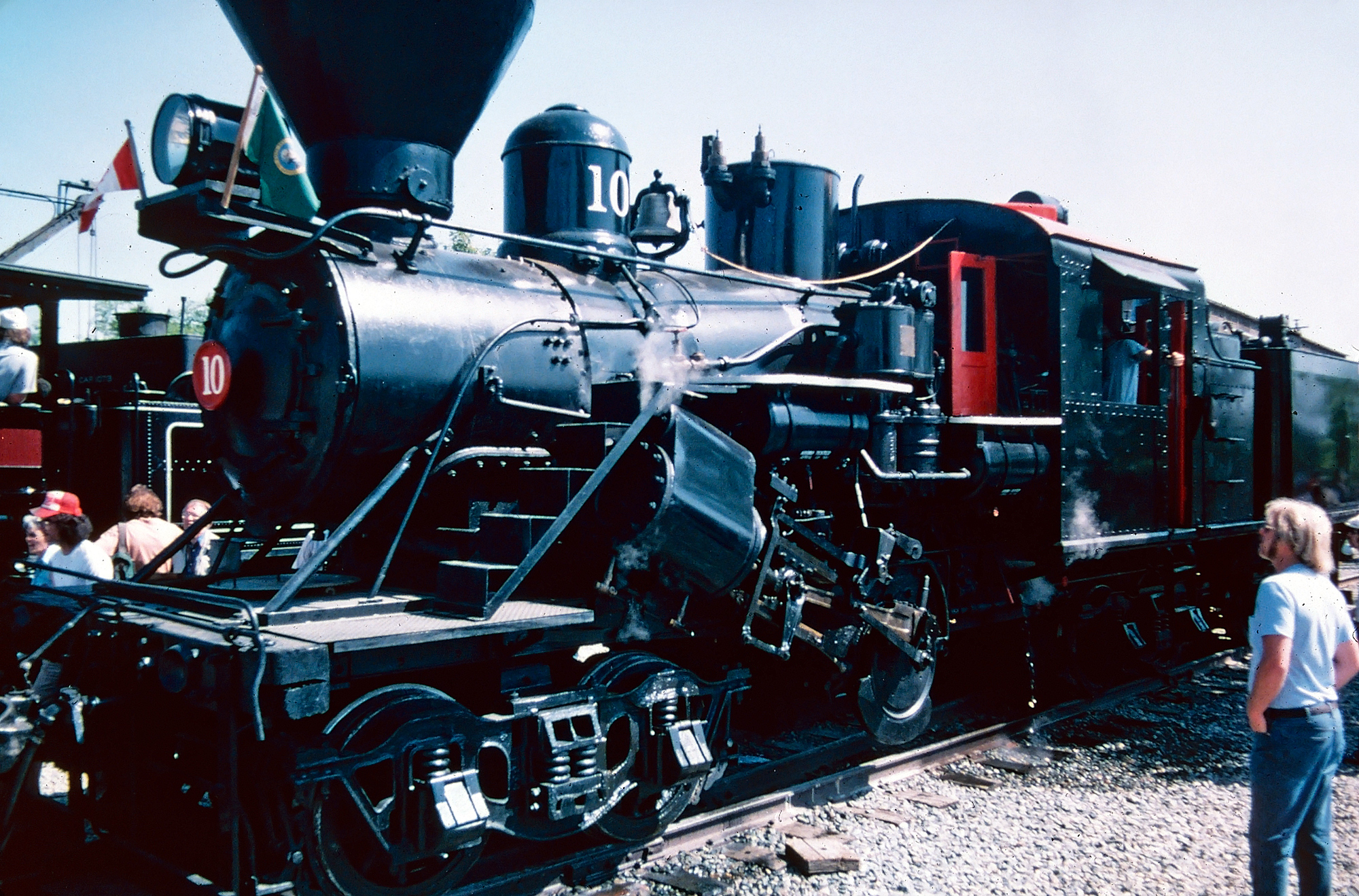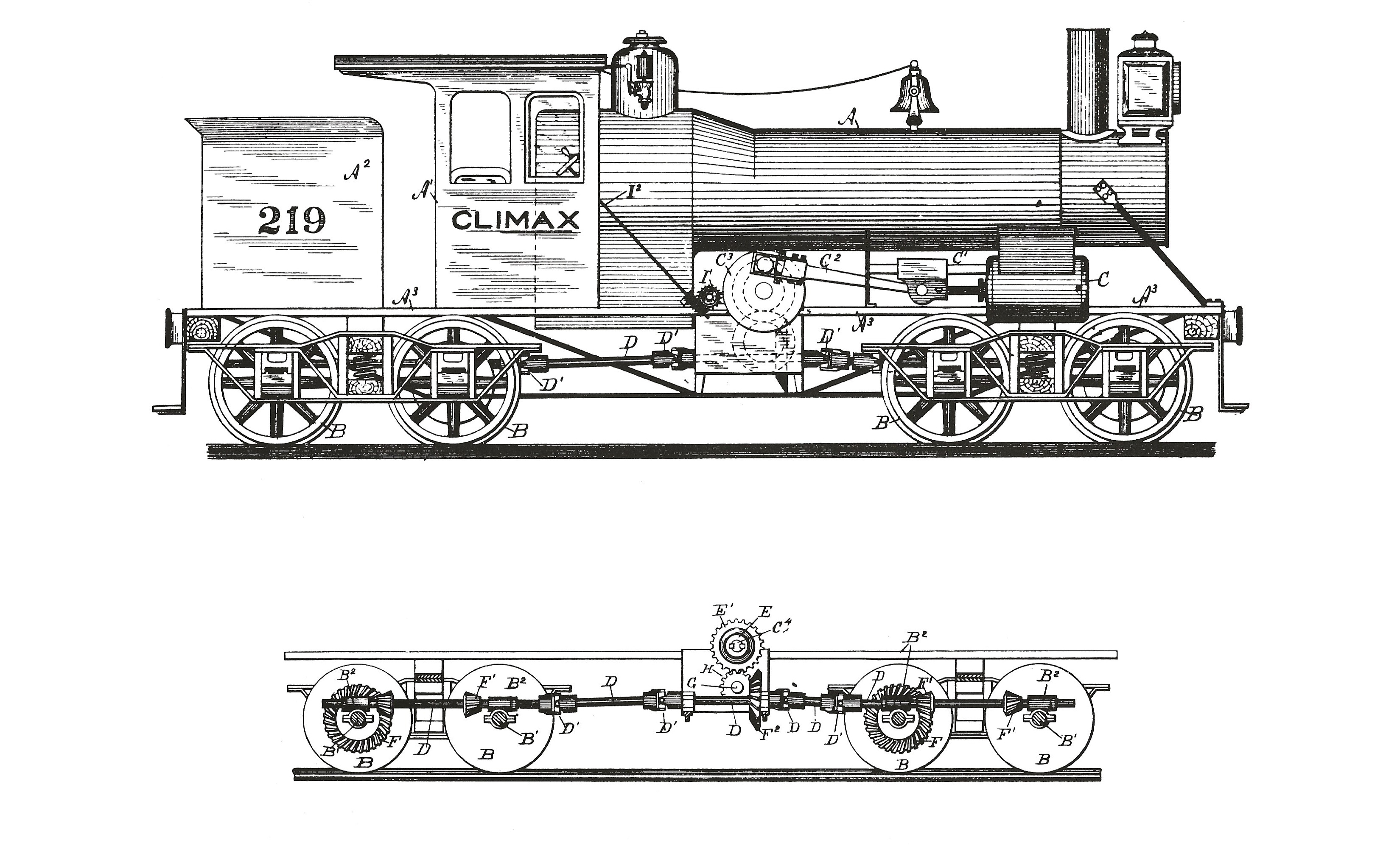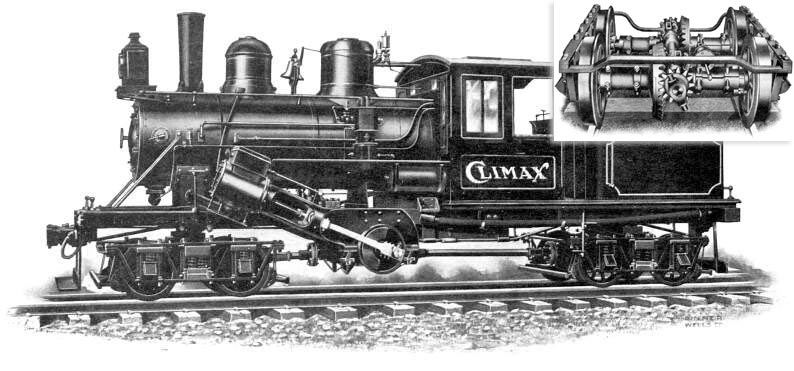Climax Locomotives (Corry, PA): Drawings, Images, Survivors
Last revised: August 25, 2024
By: Adam Burns
In the spirited age of steam locomotive innovation, the Climax emerged as a notable contender to the widely acclaimed Shay, originally conceived by Ephraim Shay in the late 1870s.
The Climax - the vision of a Pennsylvania lumberman - debuted shortly afterward and though it never quite eclipsed its rival's popularity, the geared design brought its own unique advantages.
Its final design offered notable enhancements over the Shay, particularly in terms of maintenance. The Climax boasted an ingenious redundancy feature that simplified repairs and upkeep.
Furthermore, it was engineered to support a larger boiler, thus increasing both horsepower and adhesion capabilities, enhancing its performance on the tracks.
Dominated by the Shay's established presence, the Climax saw relatively modest sales, with approximately 1,050 locomotives constructed between 1888-1928.
This figure underscores the tough market conditions and the challenging competition it faced, highlighting a fascinating chapter in the history of industrial locomotives.
Today, only twelve remain preserved , capturing the essence of a bygone industrial era. Remarkably, two of these historic locomotives still operate, serving as a moving testament to the enduring legacy of steam power innovation.
Photos
 Hillcrest Lumber Company 3-truck Climax #10 is seen here on the Mount Rainier Scenic Railroad. The locomotive was manufactured in March, 1928 by the Climax Locomotive Works and was the second-to-last unit completed. She spent her entire career on Vancouver Island, British Columbia before the company's Mesachie Lake mill shutdown in 1968. She was sold to Mt. Rainier Scenic in 1979. William Myers photo. American-Rails.com collection.
Hillcrest Lumber Company 3-truck Climax #10 is seen here on the Mount Rainier Scenic Railroad. The locomotive was manufactured in March, 1928 by the Climax Locomotive Works and was the second-to-last unit completed. She spent her entire career on Vancouver Island, British Columbia before the company's Mesachie Lake mill shutdown in 1968. She was sold to Mt. Rainier Scenic in 1979. William Myers photo. American-Rails.com collection.History
The Climax's creation is credited to the ingenuity of Charles Darwin Scott, a sawmill worker based in Spartansburg, Pennsylvania. In 1878, Scott embarked on pioneering experiments with a geared locomotive design, specifically tailored for the rigorous demands of logging operations.
This innovative effort was set against the backdrop of the Shay's early success, which hit the market in 1880. Scott's work led to the development of his own geared design, offering a new, robust tool for the logging industry.
Convinced of its potential, Scott sought a partnership with a nearby manufacturing hub. He turned to the Climax Manufacturing Company, located just under 10 miles away in nearby Corry, Pennsylvania.
The synergy between Scott's vision and the company's capabilities was so impactful that the latter soon rebranded itself as the Climax Locomotive Works, reflecting its new focus on the large-scale locomotive production.
In March 1888, this collaboration bore fruit with the completion of a prototype. This initial locomotive quickly proved its worth, as it was purchased by Imel, Powers & Shank— a company engaged in logging operations near Scandia, Pennsylvania, at Hodge Run in Warren County.
This sale marked the beginning of the Climax Locomotive's journey into the strenuous world of logging, showcasing the practical application and efficacy of Scott’s design.
Early Years
Soon after this initial copy was sold, Scott and Climax saw three more orders placed that spring convincing the lumberman that he was on to something.
After ten months of waiting he finally received his patent for the locomotive on December 4, 1888. Unfortunately, however, this is where Scott's tale in the Climax's development (and rightful credit for the design) fades.
Because of his civil engineering background, Scott's brother-in-law George Gilbert received the patent in his name instead. This arrangement was actually agreed upon by both men as Gilbert was to make drawings and plans for future improvements on the locomotive thanks to his expertise in schematics.
Sadly, however, Scott was never given credit for these enhancements. Instead, Gilbert and Rush S. Battles (from Climax) took it upon themselves to improve the locomotive for wide-scale manufacturing.
Types
Scott faced significant trials in realizing his vision. After a protracted legal battle over his patent, which he won in 1892, he found himself financially ruined and unable to further develop his locomotive. His groundbreaking concept was subsequently sold back to Climax, where it underwent further enhancements and evolved into a more refined product.
The initial types, listed as Class A, were quite rudimentary by modern standards, resembling early 19th-century conventional steam locomotives. These early models featured a vertical boiler mounted on two axles.
Functional simplicity marked the first type, which employed two vertical cylinders linked to a gearbox. The design evolved in the second version of the Class A, which maintained the basic structure but extended the frame and added two-axle trucks at each end of the locomotive.
These modifications provided better support and enhanced the locomotive’s adhesion and tractive effort, crucial for the demanding environments of logging operations.
Schematic
The evolution of the Class A reached its zenith in the early 20th century with a design that aligns more closely with contemporary images of these geared locomotives
This final iteration retained the use of vertical cylinders but introduced significant advancements including a horizontal boiler and an enclosed cab, enhancing both functionality and operator comfort.
The subsequent models, notably the Class B and Class C, bore a resemblance in technology to the well-known Shays, albeit with unique modifications.
These models employed similar technological principles but executed them in a distinctively Climax manner, showcasing a blend of traditional design and innovative engineering that characterized the locomotive's ongoing development.
According to William E. Warden in his book West Virginia Logging Railroads, the Climax gained adhesion by:
"...employing two cylinders, one on each side of the boiler. The cylinders were neither vertical nor horizontal at an angle of approximately 25 degrees and the piston rods were connected to a line shaft centered under the boiler and mid-way between the trucks, which thus powered either two or three trucks."
Classes
The short table below lists these classes:
Class A: Two Vertical Cylinders, Two Trucks
Late Class A: Two Vertical Cylinders, Two Trucks, Horizontal Boiler
Class B-60: Two Cylinders Angled at 23.5 Degrees Permitting An Increase In Length, Two Trucks
Class C-60: Two Cylinders Angled at 23.5 Degrees, Three Trucks
The variety within the Class A models was particularly notable, with Climax offering the locomotive in numerous styles and configurations tailored to meet the specific requirements of different customers.
In a significant development that marked the brand's evolution, the Class B design made its debut around 1893. These models ranged in weight from 17 to 60 tons, accommodating a broad spectrum of track conditions and hauling capacities.
Notably, the Class B was the first in the series to feature cylinders mounted at a 45-degree angle, a design innovation that enhanced the locomotive's operational efficiency. This adaptation underscored Climax's commitment to refining its engineering approaches in response to the practical demands of railroad transportation.
Debuting in 1897, the Class C was the largest, heaviest, and most powerful. The model was available in sizes ranging from 50 to 100 tons and the only style offered with a three-truck setup. In many ways the Class C was the most popular for the reasons mentioned above.
However, it also had an additional advantage. After 1914, Climax swapped out its Stephenson valve gear for the Walschaert design. Because it was placed on the outside of the locomotive and had fewer moving parts the Walschaert was less expensive and easier to maintain.
Decline
During the 1910s and early 1920s, the logging railroad industry experienced its golden era, driving robust sales of geared locomotives like the Climax.
However, by the latter part of that decade, the demand began to wane. In September of 1928, amidst declining sales, the assets of the company were acquired by the General Parts Corporation. While the new proprietor continued to supply replacement parts, it ceased production of new locomotives.
Today, the legacy of the Climax steam locomotives endures, with only 20 of these historical machines surviving around the globe—an enduring testament to their once-critical role in the logging and rail transportation industry.
Preservation
There are currently two locations to view a Climax in active service; Moore-Keppel & Company/Middle Fork Railroad #9 on the Cass Scenic Railroad and the White Mountain Central Railroad in New Hampshire.
Prior to 2020 you could also ride Hillcrest Lumber Company 3-truck #10 (pictured at the top of this page) at the Mount Rainier Scenic Railroad in Washington state. However, the tourist line has since closed and the locomotive is currently stored.
Thanks to William Simonton for help with the information on this page.
Extant Examples
| Engine Number | Class | Wheel Arrangement | Track Gauge | Original Owner/Preserved As | Current Location | Current Status | Builder Information | Notes |
|---|---|---|---|---|---|---|---|---|
| 9 | C-70 | Climax (3-Truck) | 4' 8 ½" | Moore-Keppel & Company/Middle Fork Railroad | Cass Scenic Railroad State Park (Cass, West Virginia) | Operational | Climax #1551 (1919) | Built new for the Moore-Keppel & Company's Middle Fork Railroad as #9. Later renumbered 6. Restored to operation in 9/2019. Only operating 3-truck of its type in America. |
| 1 | B-30 | Climax (2-Truck) | 4' 8 ½" | Barclay Chemical Company | Corry Historical Museum (Corry, Pennsylvania) | Display | Climax #1681 (3/1927) | Later sold to Southern New York Railway (#1) of Oneonta, NY. Preserved in 6/1960. |
| 4 | A-15 | Climax (2-Truck) | 36" | Wild Goose Mining & Trading Company | Corry R.A.I.L.S. (Corry, Pennsylvania) | Operational Restoration | Climax #313 (4/1902) | Built as Golofin Bay Railway (313) of Council City, Alaska. |
| 3 | B-55 | Climax (2-Truck) | 4'-8½" | Middle Fork Railroad (Moore-Keppel & Company) | Durbin & Greenbrier Valley Railroad/Cass Scenic Railroad (Durbin, West Virginia) | Overhaul | Climax #1059 (11/1910) | Acquired by the Connecticut Electric Railway Association of Warehouse Point, Connecticut in 1961. Purchased by the Durbin & Greenbrier Valley in 2001. |
| 3 | B-50 | Climax (2-Truck) | 48" | WM Ritter | Roaring Camp & Big Trees Railroad (Felton, California) | Restoration | Climax #1692 (12/1928) | Built as Elk River Coal & Lumber Company #3. Later transferred to the Clinchfield Coal Company and WM Ritter. This was the last Climax engine ever built and the last one to be retired from commercial service in 1956. Built as a standard-gauge locomotive but converted to 48-inch gauge for the Carroll Park & Western Railroad of Bloomsburg, Pennsylvania in 1962. Acquired by the Roaring Camp & Big Trees in 1972. |
| 6 | Climax (2-Truck) | 4' 8 ½" | White Mountain Central Railroad | White Mountain Central Railroad/Clark's Trading Post (Lincoln, New Hampshire) | Operational | Climax #1603 (6/1921) | Built as Woodstock Lumber Company #6 (Woodstock, NH). Later worked as Parker-Young Company (#6), Beebe River Railroad (#6), and East Branch & Lincoln Railroad (#6). Acquired by Clarks Trading Post in 1952. | |
| 10 | Climax3Tr | 4'-8½" | Hillcrest Lumber | Mineral Shops, Mt. Rainier Scenic Railroad, Mineral, WA | stored | Climax #1693, 1928 | Was operational, but is now placed in storage due to the closure of the Mt. Rainier Scenic Railroad in May 2020. | |
| 3 | B-40 | Climax (2-Truck) | 36" | Champion Fiber | Cradle of Forestry (Pisgah National Forest, North Carolina) | Display | Climax #1323 (1914) | Built as Champion Fibre Company #3. Sold to the Ely-Thomas Lumber Company (#7) in 1947. Acquired by private collector of Harold Allen of Ann Arbor, MI in 1956. Preserved at the Cradle of Forestry since 1983. |
| 3 | C-75 | Climax (3-Truck) | 4' 8 ½" | Fruit Growers Supply Company | RailGiants Train Museum (Pomona, California) | Display | Climax #932 (4/1909) | Built as Northern California Lumber Company #3. Sold to Fruit Growers Supply Company #3 in 1913. Donated to the Railway & Locomotive Historical Society (Pomona) in 1955. |
| 3937 | B | Climax (2-Truck) | 4' 8 ½" | Soniat & DeBlieu (Phoenix Mine & Gratiot River) | The Retreat at Artesian Lakes (Romayor, Texas) | Display | Climax #28, 1893 | - |
| 4 | B-40 | Climax (2-Truck) | 4' 8 ½" | WH Mason Lumber Company | Railroad Museum of Pennsylvania (Strasburg) | Display | Climax #1237 (6/1913) | Built as Moore-Keppel & Company #4. Became WH Mason #4 in 1948. Acquired by the Edaville Railroad in 1956. Preserved at the Railroad Museum of Pennsyvlania in 1992. |
| 4 | B-60 | Climax (2-Truck) | 4' 8 ½" | Holmes-Eureka Lumber Company | Roots of Motive Power (Willits, California) | Display | Climax #1621, (10/1922) | Built as Holmes-Eureka Lumber Company #4. Became Pacific Lumber Company #38 in 1937. Donated to a private owner in 1956 and then acquired by Roots of Motive Power in 1990. |
Sources
- Adams, Kramer A. Logging Railroads Of The West. New York: Bonanza Books, 1961.
- Fetters, Thomas. Logging Railroads Of South Carolina. Forest Park: Heimburger House Publishing Company, 1990.
- Fetters, Thomas. Logging Railroads Of The Blue Ridge And Smoky Mountains, Volume I (Gold Mountain, Black Mountain And White Top). Hillsboro: TimberTimes, 2007.
- Fetters, Thomas. Logging Railroads Of The Blue Ridge And Smoky Mountains, Volume 2 (Tallulah Falls, Anna Ruby Falls, And Jeffrey's Hell). Hillsboro: TimberTimes, 2010.
- Gove, Bill. Logging Railroads Of The Adirondacks. Syracuse: Syracuse University Press, 2006.
- Gove, Bill. Logging Railroads Of New Hampshire's North Country. Littleton: Bondcliffs Books, 2010.
- Kline Jr. Benjamin F.G. Tall Pines And Winding Rivers: The Logging Railroads Of Maryland. Strasburg: The Friends Of The Railroad Museum Of PA, 2007 (Second Edition).
- King, Frank A. Minnesota Logging Railroads. Minneapolis: University Of Minnesota Press, 2003 (First University Of Minnesota Press Edition).
- Labbe, John T. and Replinger, Peter J. Logging To The Salt Chuck. Seattle: North West Shore Line, 1990.
- Lawson Jr., Thomas. Logging Railroads Of Alabama. Birmingham: Cabbage Stack Publishing, 1996.
- Warden, William E. West Virginia Logging Railroads. Lynchburg: TLC Publishing, 1993.
Recent Articles
-
Kentucky Railroad Museums: A Complete Guide
Apr 20, 25 03:17 PM
Kentucky has long contained a mix of important through main lines and rich bituminous coal seams for the railroad industry. Today, a handful of museums can be found across the state. -
Kansas Railroad Museums: A Complete Guide
Apr 20, 25 02:58 PM
Located within the Heartland, Kansas has always been an important agricultural state for railroads. A number of museums can be found throughout the state. -
Iowa Railroad Museums: A Complete Guide
Apr 20, 25 02:20 PM
The state of Iowa was once home to thousands of miles of railroads serving its rich agriculture industry. Today, several museums dot the state.

